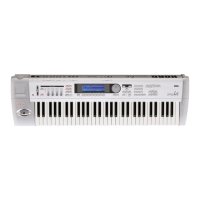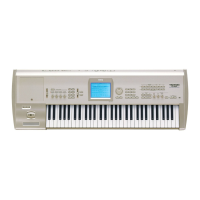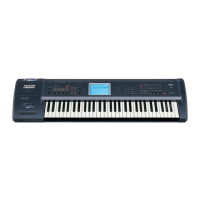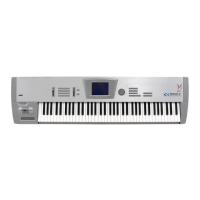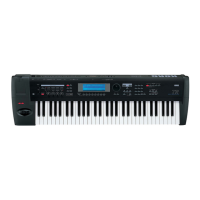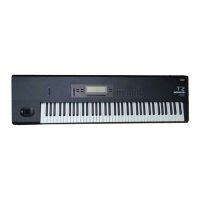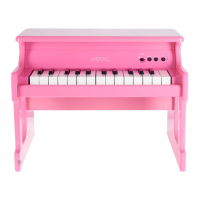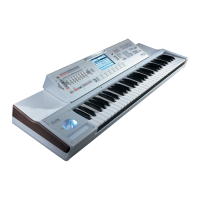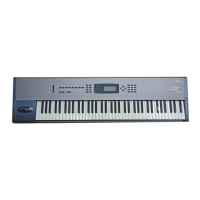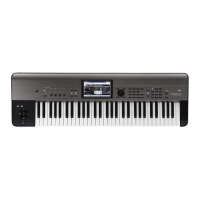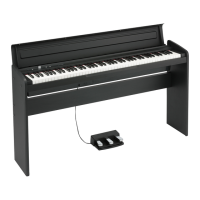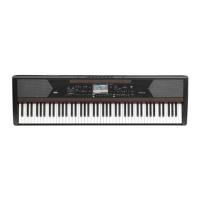4
Decay (Decay Time) [–10…+00…+10]
This adjusts the Decay Time and Slope Time of the filter EG
and amp EG.
With an adjustment of +00, the value of the program param-
eters will be unchanged.
Positive (+) settings will lengthen the Decay Time and Slope
Time beyond the values that were set. With an adjustment of
+10, the times will be 99.
Negative (–) settings will shorten the Decay Time and Slope
Time. With an adjustment of –10, the times will be 0.
IFX Bal (IFX Balance) [–10…+00…+10]
This adjusts the “W/D(Wet/Dry)” setting of the insertion
effect.
With an adjustment of +00, the value of the program param-
eters will be unchanged.
Positive (+) settings will raise the Wet level above the pro-
gram setting, and lower the Dry level. With an adjustment of
+10, the setting will be “Wet” - the effected signal only.
Negative (–) settings will lower the Wet level below the pro-
gram setting, and raise the Dry level. With an adjustment of
–10, the setting will be “Dry” - the signal is unaffected.
MFX Bal (MFX Balance) [–10…+00…+10]
This adjusts the master effect “Rtn1 (Return1)” and “Rtn2
(Return2)” (7.2–1a) settings as a whole.
With an adjustment of +00, the value of the program param-
eters will be unchanged.
Positive (+) settings will raise the return levels above the
program setting.
With an adjustment of +10, the setting will be 127 (maxi-
mum).
Negative (–) settings will lower the return levels below the
program setting.
With an adjustment of –10, the setting will be 0.
■ 1.1–2c: UTILITY
☞ “Write Program,” “Select by Category” (1.1–1c)
1.1–3: Arp (Arp. Play)
While arpeggiator parameters are for the most part edited in
PROG 6.1: Ed-Arp., Some major parameters can be edited
here as well. When you are playing in PROG 1.1: Play, you
can edit the arpeggiator in realtime, such as changing the
arpeggio pattern etc.
You can also use the REALTIME CONTROLS C-mode
[TEMPO], [ARP-GATE], and [ARP-VELOCITY] knobs to
edit the arpeggio in realtime (
☞BG p.27).
1.1–3a: Arpeggiator
Pattern [P000...P004, U000(INT)...U215(User)]
Reso (Resolution) [ , , , , , ]
Octave [1, 2, 3, 4]
Sort [Off, On]
Latch [Off, On]
Key Sync. [Off, On]
Keyboard [Off, On]
Make settings for the program arpeggiator (☞“PROG: Ed-
Arp.”). These parameters can also be set from 6.1: Ed-Arp.
setup page (
☞6.1–1a).
■ 1.1–3b: UTILITY
☞ “Write Program,” “Select by Category” (1.1–1c)
Octave Octave of OSC 1 and 2
Stretch Tr anspose and Tune of OSC 1 and 2
OSC Bal High Level and Low Level of OSC1 and 2
Level Amp1 Level, Amp2 Level
Attack Amp EG Attack Time, Start Level, Attack Level,
Level Modulation S, Time Modulation A of Amp 1
and 2, and Filter EG Attack Time of Filter 1 and 2
Decay AmpEG Decay Time, Slope Time of Amp 1 and 2,
Filter EG Decay Time and Slope Time of Filter 1
and 2
IFX Bal W/D (Wet/Dry) balance of the IFX effect
MFX Bal Master Effect RTN1, 2 (Return1, 2)
1.1–3a
1.1–3b
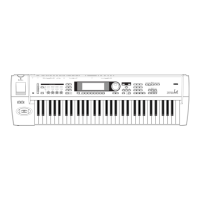
